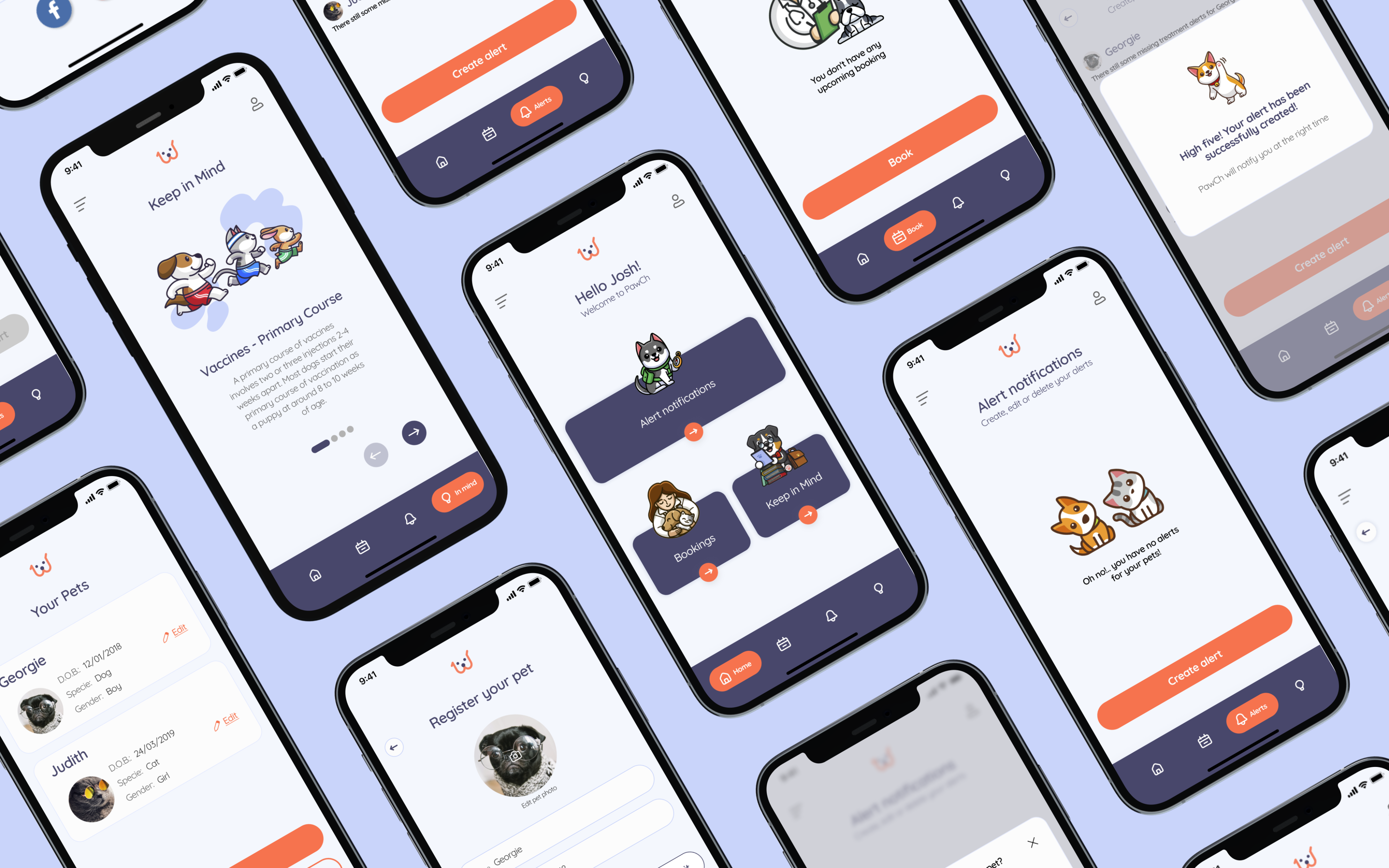PawCh
PawCh is a mobile app that helps pet owners stay on top of their pets’ health — from vaccinations and routine treatments to regular vet visits. In the rush of everyday life, it’s easy to lose track of schedules and reminders, but caring for our pets should never slip through the cracks. They rely on us completely and PawCh was created to help us return that care with ease and confidence.
Overview
Company
Capstone Project - UX/UI Bootcamp
Role
Product Designer, UX/UI Designer
Year
2022
The Challenge
Our Problem
Pet ownership reached an all-time high of 59% in 2020/21. However, by 2021, over 6 million pets in the UK were not receiving regular treatments or vaccinations — a trend that can lead to declining health over time and result in costly treatments down the line.
Our Goal
This project aims to understand the challenges pet owners face in regularly vaccinating and treating their pets. Why do some owners neglect these treatments? What obstacles do they encounter when seeking care for their animals? The project also seeks to raise awareness about the importance of routine preventive care and to develop a system that notifies pet owners about what treatments are needed and when. Through this initiative, I hope to increase the rate of preventive treatments and vaccinations.
Our Data

- 9.6 million pet dogs are living in the UK.
- 23% of dogs have not received regular booster.
- More than 20% of dogs have not received worm and flea treatment.
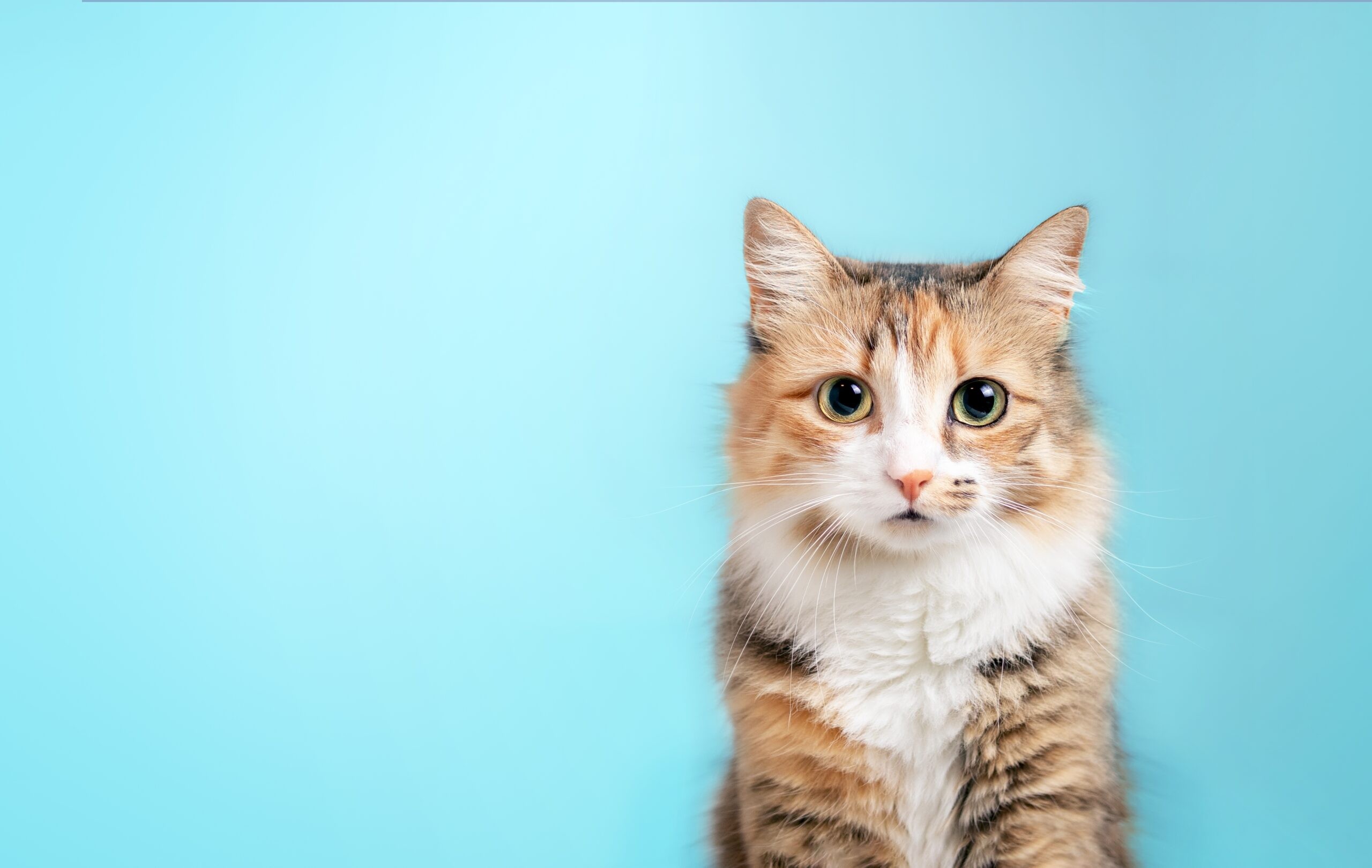
- 10.7 million pet cats are living in the UK.
- 39% of cats have not received regular booster.
- More than 20% of cats have not received worm and flea treatment.

- 900.000 pet rabbits are living in the UK.
- 50% of rabbits have not received regular booster.
- More than 70% of rabbits have not received worm and flea treatment.
Research
I began with secondary research, uncovering that around 8% of owners found it difficult to make vet appointments and 7% struggled to keep up with treatments due to lack of knowledge or simple forgetfulness — representing nearly a million pets at risk.
To move beyond statistics, I conducted in-depth interviews with pet owners aged 25–65. These open conversations focused on stories — not just opinions — to uncover real habits, frustrations, and emotions.
Key insights:Six recurring themes emerged:
- Costs: Veterinary care can be expensive, making owners delay visits.
- Emotional value: Pets are seen as family, but care decisions are often emotional rather than planned.
- Access: Some owners find it hard to schedule or remember appointments.
- Information gaps: Many are unsure about what treatments are needed and when.
- Forgetfulness: Life gets busy, and reminders get lost.
From these themes, I developed a persona — Josh, a 32-year-old dog owner juggling work, family, and pet care. By mapping Josh’s emotional journey after realising he’d missed a vaccination, I uncovered critical moments of stress, guilt, and uncertainty — and potential opportunities to step in with reassurance and structure.
Josh’s needs inspired the core challenge:
How might we support busy pet owners in remembering and managing their pets’ health routines with ease and confidence?
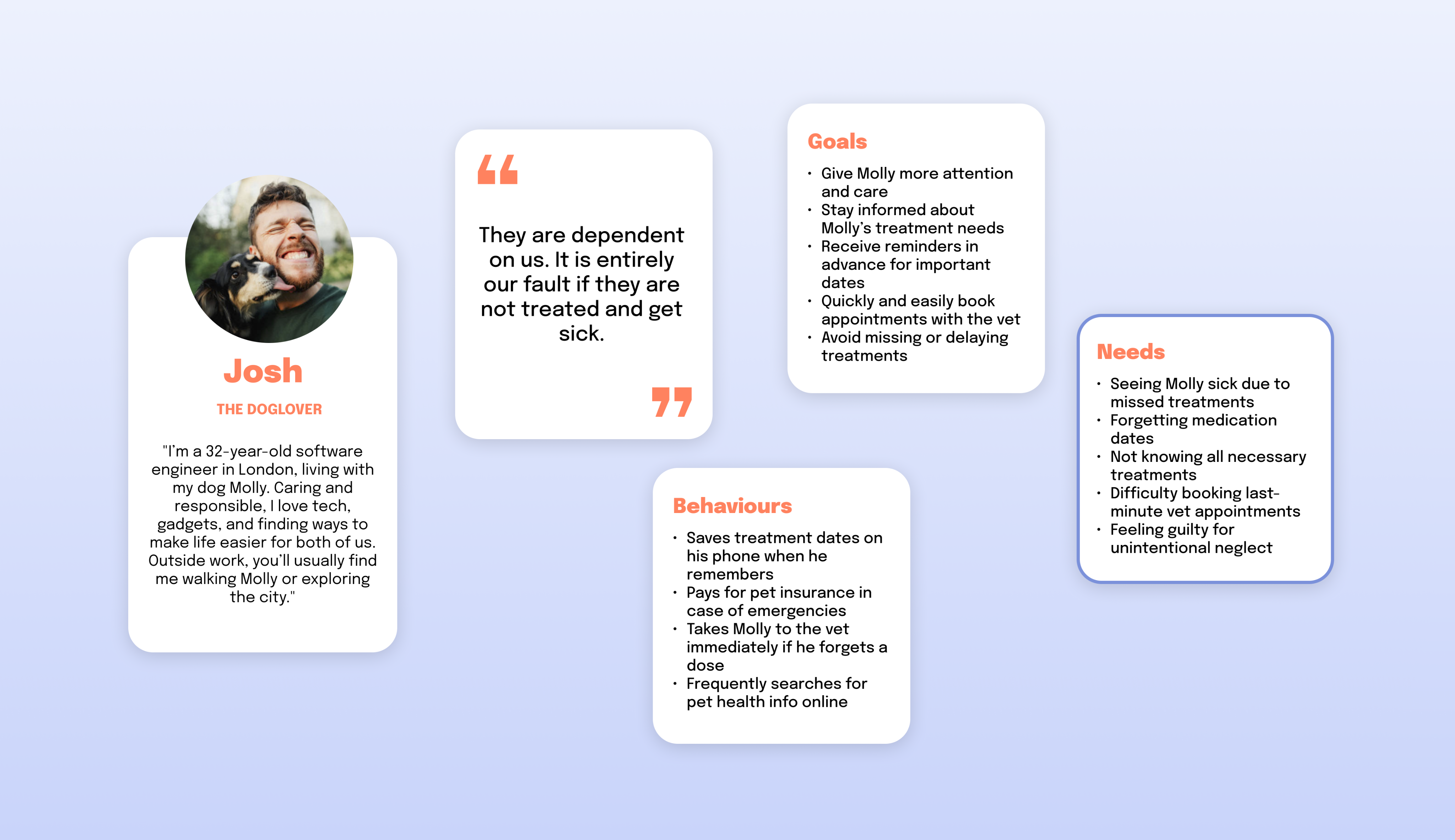
After synthesising insights, I ran ideation sessions and Crazy 8’s sketching, rapidly exploring different ways to simplify the user journey. The goal wasn’t perfection — it was to explore.
I moved from sketches to low-fidelity wireframes, then into interactive prototypes for testing.
Testing
Two rounds of user testing (five users per round) helped validate the concept.
The aim: could users easily register their pet, set reminders, and book an appointment?
Results:
- Testers completed tasks with minimal confusion.
- Icons and some copy were unclear at first — small refinements made a big difference.
- 8/10 users highlighted alerts as their favourite feature.
- The app was described as “trustworthy”, “easy to navigate”, and “welcoming”.
Each round of feedback shaped subtle improvements — more intuitive icons, simpler text, and clearer educational content. With each iteration, PawCh felt friendlier and more natural.
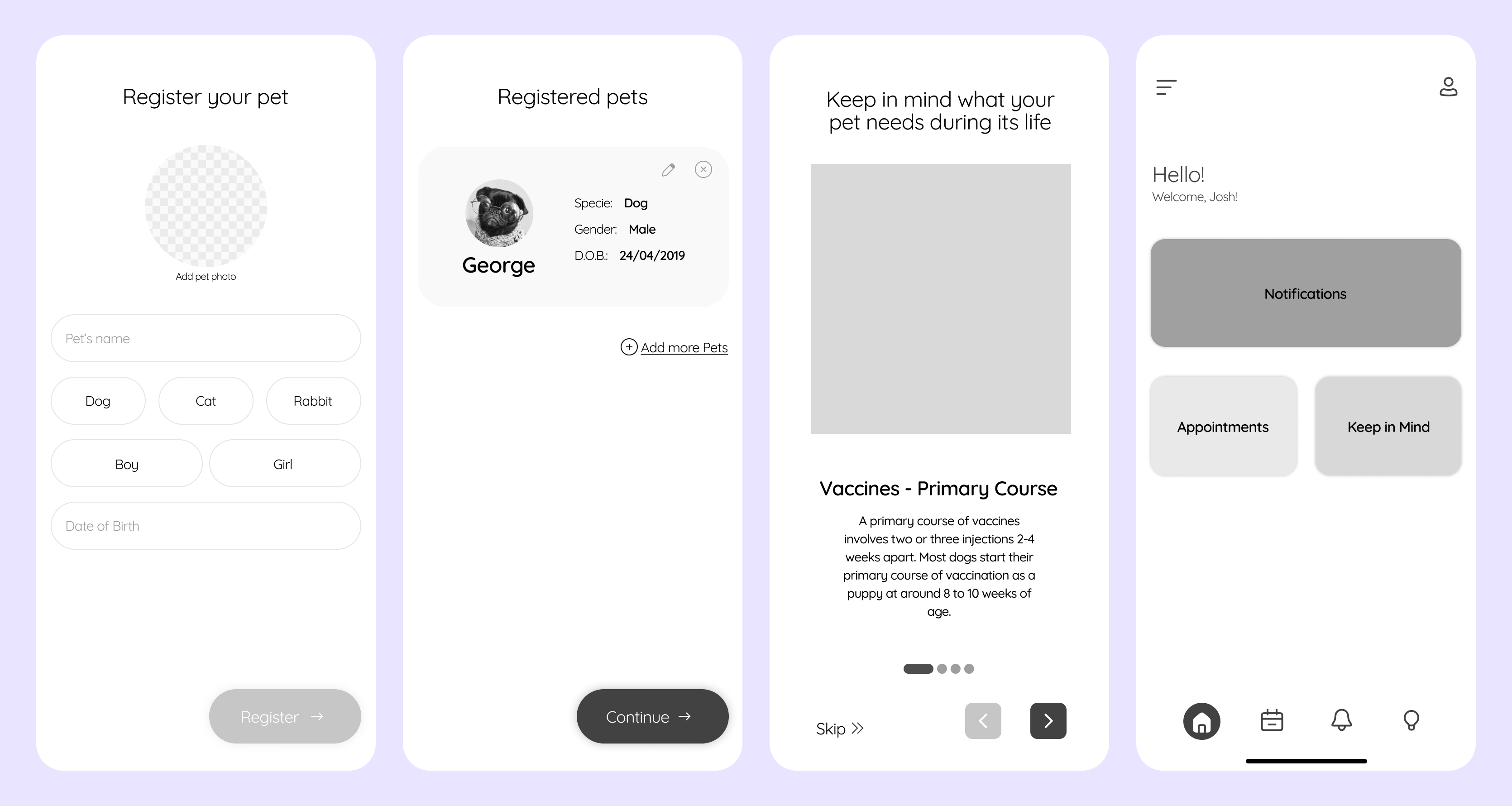
Brand
I wanted PawCh to feel like a friend — not a system. The visual identity draws from the emotional bond between pets and humans: warmth, trust, and affection.
- Colours: Soft, earthy tones that evoke comfort and care.
- Typography: Rounded, friendly typefaces that are readable and reassuring.
- Wordmark: A subtle pet-inspired shape within the lettering makes the brand instantly recognisable and heartfelt.
From onboarding cards to empty states, every detail was designed to feel positive and supportive — a small smile in every interaction.
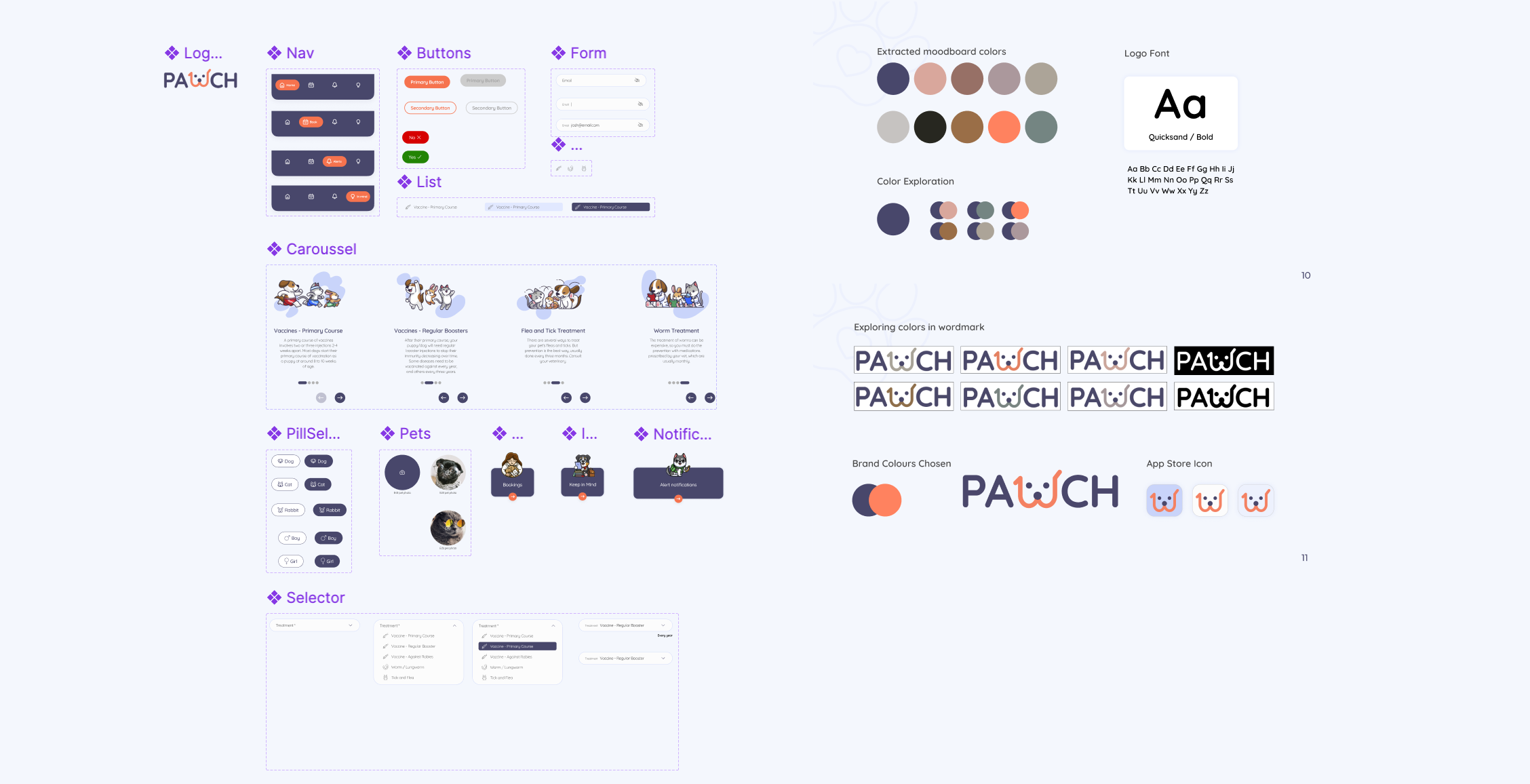
The App
I know you’re eager to see PawCh in action. So, fasten your seatbelts — or rather, your collars — and let’s go!
Here, you’ll see how every detail of the app has been designed to make caring for pets simpler, more organised, and, of course, full of love.
Onboarding Playful illustrations guide users through a friendly registration flow, helping them understand the importance of each treatment right from the start.
Setting Alerts
Creating reminders for vaccinations or treatments is simple and intuitive. Users can select which treatments to track and set automatic alerts with just a few taps. If they ever forget to create one, the app gently suggests what’s missing — keeping their pets’ health routines on track without adding pressure.
Appointments
A seamless booking flow connects owners to nearby partner vets, turning a once time-consuming task into a quick, reassuring experience.
Potential Impact
Although PawCh hasn’t been commercially launched, it was designed with real-world benefits in mind.
For Society:
- Improving preventive animal healthcare: By reminding pet owners about vaccinations and treatments, PawCh could help reduce the number of animals developing preventable diseases — improving overall pet wellbeing and life expectancy.
- Reducing costs for emergency treatments: Prevention is more affordable than cure. The app would directly contribute to reducing financial strain on families, who often only seek veterinary help when an issue has already become serious.
- Greater awareness around pet care: With clear, accessible information, PawCh also functions as an educational tool, encouraging more responsible and consistent pet ownership.

For Clinics:
- Increasing in routine appointment bookings: By integrating reminders with partner clinics, the app has the potential to generate a more regular and predictable flow of appointments, particularly for check-ups and vaccinations.
- Improving client retention and demand planning: PawCh helps build a digital bridge between pet owners and clinics, making communication easier and encouraging regular visits — which can reduce the number of missed or overdue treatments.
- Insightful data for decision-making: Over time, the app could gather data on treatment trends, seasonal behaviours, and booking patterns — providing valuable insights for clinics to optimise services and promote preventive care campaigns.
Takeaways
From day one, I knew this project would be close to my heart. As a proud pet parent to my four-legged buddy Chewbacca (yes, named after that Chewbacca), designing PawCh felt personal. It's more than just an app — it’s a tribute to the love we share with our pets and a tool to help us take better care of them.
One of the biggest lessons I learned throughout this journey is that good research isn’t about asking opinions — it’s about uncovering behaviours. The most valuable insights came when I encouraged users to describe what they actually do, not just what they think. Open-ended questions opened the door to stories, habits, and emotions I wouldn’t have captured otherwise. I also realised that interviews aren’t casual conversations — they’re opportunities to truly listen and observe, to catch the small things that often say the most.
On the design side, working within iOS Human Interface Guidelines was a game-changer. Instead of reinventing the wheel, I leaned on proven patterns to make the experience feel natural, intuitive, and familiar — exactly what users expect when caring for someone they love.
This project taught me how to balance empathy, structure, and creativity — all while keeping users (and their furry companions) at the heart of every decision.
App illustrations by Alfrey Davilla.
